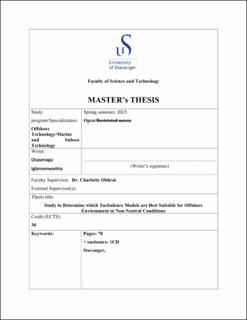| dc.description.abstract | Wind turbines have been experiencing a rapid development over the years and there has been a shift from onshore to offshore which has been due to many reasons as will be discussed in the introduction. The lateral and vertical coherences at various locations on the floating wind turbine rotor were thought to have an impact on the floater motions due to their spatial connection. It has been hypothesized that the wind turbine components will suffer substantial fatigue damage unlike most offshore structures which are more affected by ultimate limits states because of the unstable air stability conditions that more frequently occur offshore. Loads, power quality, grid interaction, weather, and power performance are all factors emphasized. We also investigate the impact of turbulence on the environment and how it pertains to this wind farm, as well as the unique qualities of offshore wind turbines. While taking analysis of atmospheric stability and various turbulence spectral models, we will be able to ascertain the one that is most suitable for offshore environment in a non-neutral condition. In this research it was observed that the peak value for the non-dimensional velocity spectra was larger for the neutral stability conditions (with the maximum value reaching unity), followed by the unstable and stable condition, respectively. In addition, the difference in the normalized spectra at high frequencies was negligible, regardless of the stability condition. The Welch and the FFT spectra matched in the higher frequency range of the spectra, from frequency f above 10^(-2) Hz, but in the lower frequency range the Welch spectra exceeded the FFT spectra. There was negative co-coherence for all the vertical separations, for the separations where large decay of the co-coherence was observed. For the separation between 37 and 40 m a.m.s.l, the negative co-coherence was small. | |
